How To Set Up Literacy Blocks That Align With the Science of Reading
This post may contain affiliate links, and I will earn a commission if you purchase through these links. Please read the disclosure policy for more details.
Since I have written about the science of reading, heart words, and explicit phonics instruction, so many of you have reached out and asked, “so how do I set up my literacy block and work with students in small groups?”
I know it can be overwhelming learning that what you’ve been doing needs to change, especially with all the challenges teachers face with time and curriculum restraints.
In this post, I’m sharing a literacy block template you can use to set up your reading and writing instruction, just in time for the new school year!
But before I get into it, make sure you complete the right literacy assessments before planning out anything for the year.
What should literacy instruction include?
The 3 main areas that you want to focus on in your literacy instruction are:
- Decoding
- Fluency
- Comprehension
When planning out your literacy block, make sure every activity targets one of these three areas.
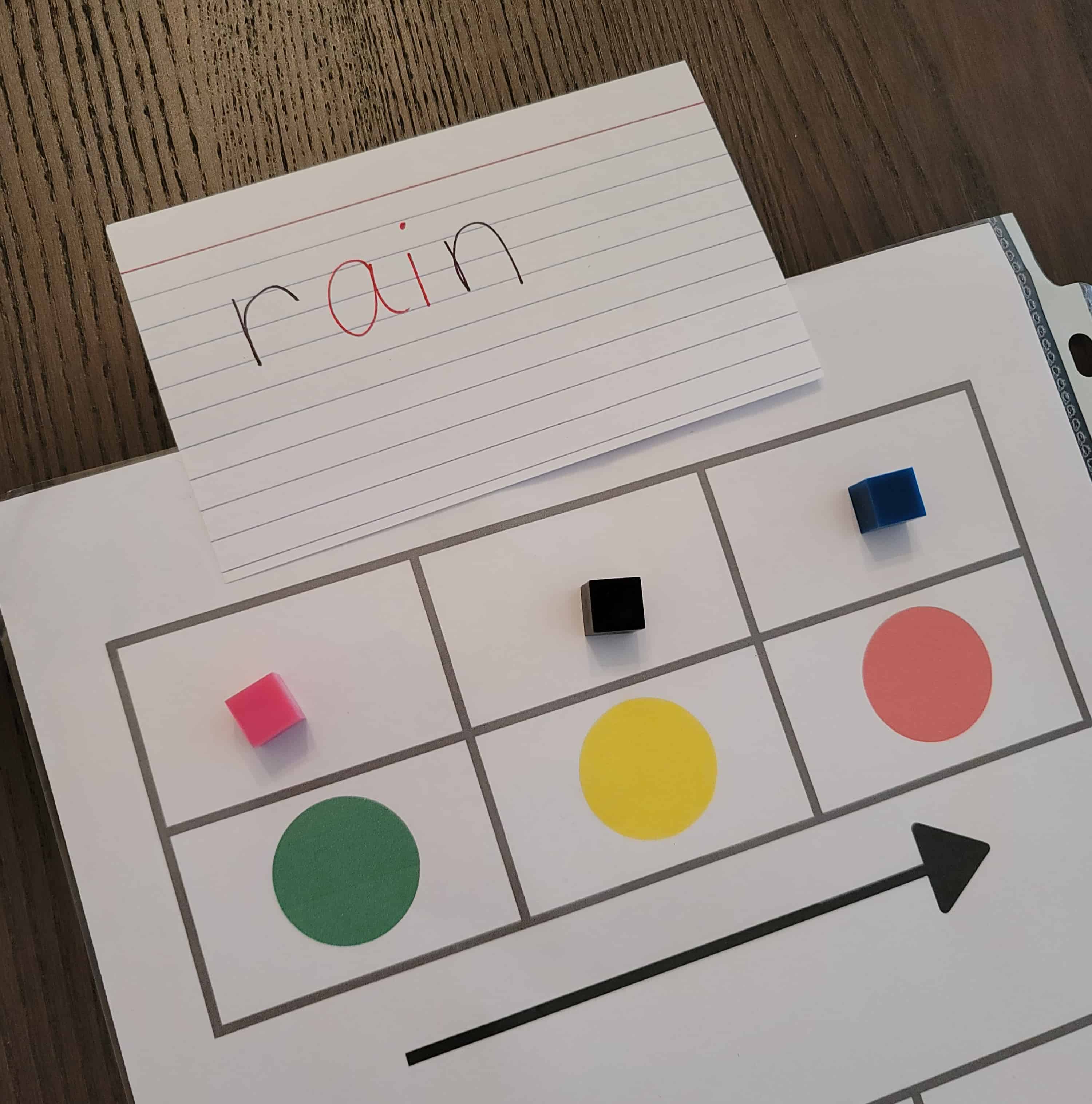
Decoding
Decoding requires phonological awareness, phonics, and blending and segmenting. Students should be able to hear and manipulate sounds in words, understand relationships between graphemes and phonemes, and manipulate parts of words. These are the things you will focus on in your phonics lessons and activities.
Some activities that you can include in your lessons that address decoding include:
- Elkonin boxes
- Syllable splitting
- Syllable blending
- Segmenting phonemes
- Blending phonemes
- Phoneme deletion and subsitution
- Highlight target phonics pattern
- Phonics games
- Memory or matching game
- Word building
- Search for target phonics pattern
- Word work worksheets
- Heart words (high frequency words)

Fluency
Fluency requires the ability to read smoothly, with expression, at the right pace, and with attention to punctuation. Including activities that build fluency is important.
Some activities that address fluency include:
- Read alouds
- Shared reading
- Re-reading
- Independent reading
- Listening to an audio book
- Choral reading
- Partner reding
- Readers’ Theatre
- Grammar instruction
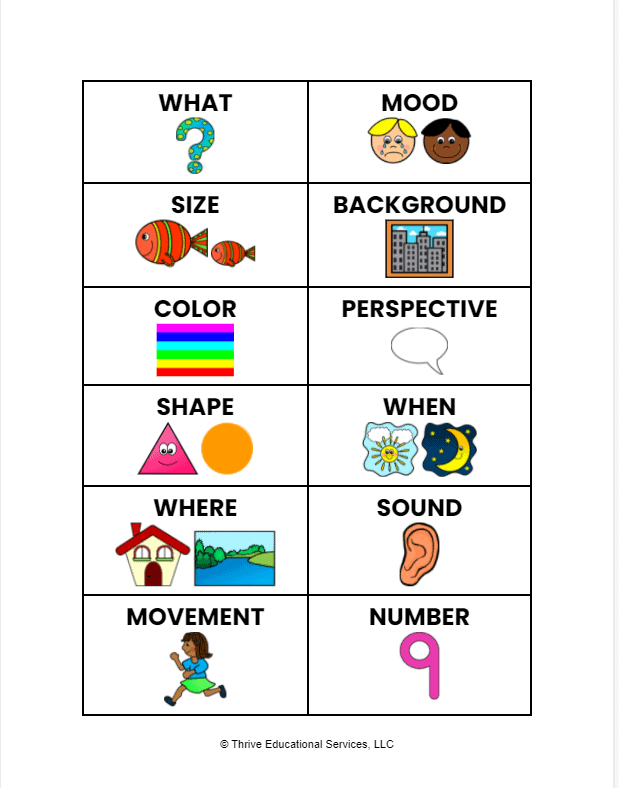
Comprehension
Comprehension requires vocabulary knowledge, background knowledge, and language comprehension. These are the things you will focus on in your comprehension instruction.
Some activities that address comprehension include:
- Reading a nonfiction passage to increase background knowledge
- Vocabulary instruction
- Retelling
- Summarizing
- Shared reading
- Read-Alouds
- Independent reading
- Science & social studies content (increases background knowledge)
- Think alouds
- Stop and retell
- Visualization
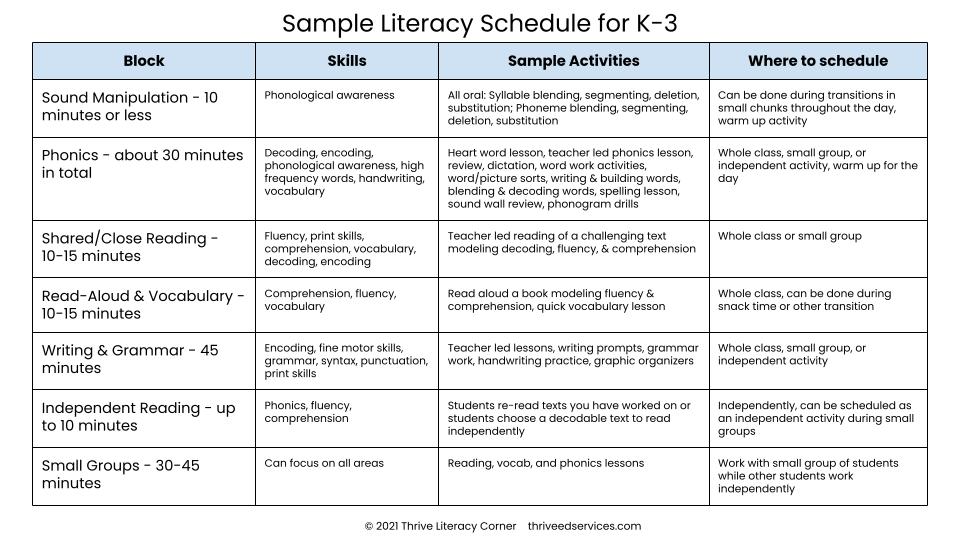
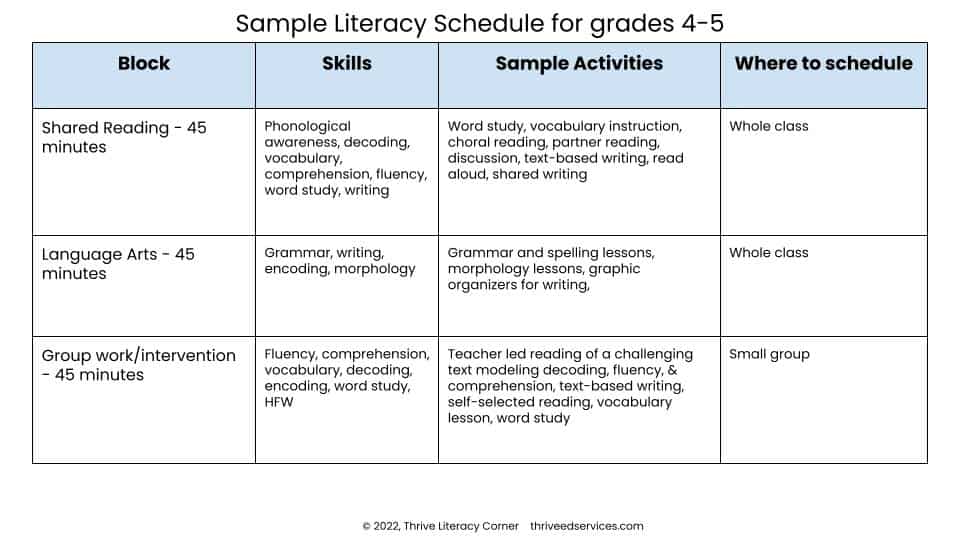
Literacy Block Schedule Template
I know that every school has different time requirements and even specific activity requirements for reading and writing instruction. You might be able to adapt what you are currently doing and swap some activities or change up the timing to fit with what research says actually works to improve reading.
Sometimes administrators need a little education on why certain programs or activities need to be updated or changed, and hopefully, you don’t encounter a lot of pushback with this.
Here is a sample of what a literacy block should look like for kindergarten through third grade:
- Sound Manipulation – up to 10 minutes of activities that build phonological awareness
- Phonics – about 30 minutes of activities that focus on decoding, encoding, phonological awareness, high frequency words, and vocabulary
- Shared or close reading – 10 minutes of activities that address print and book skills, phonics, fluency, comprehension, and vocabulary
- Read-aloud & vocabulary – 15 minutes of activities that focus on comprehension, vocabulary, and modeling fluency
- Writing – 30-45 minutes of activities that teach encoding, fine motor skills, and grammar
- Independent Reading – 10 minutes or less
- Small Groups – 30-45 minutes of activities that reinforce phonological awareness, phonics, fluency, comprehension, and vocabulary
Here is a sample of what a literacy block should look like for fourth and fifth grade:
- Shared Reading – 45 minutes of activities that build comprehension, fluency, decoding, vocabulary, phonological awareness, and writing
- Language Arts – 45 minutes of activities that focus on grammar, writing, encoding, and morphology
- Small groups/intervention – 45 minutes of activities that address all areas of literacy in differentiated groups of students
These activities DO NOT have to be scheduled in this order, nor do the activities need to stick within these recommended time frames.
Think of transition times that you can do phonemic awareness activities like while walking to lunch. You could do a read-aloud while students eat their morning or afternoon snack. Some of these activities could be independent small group activities that your students work on while you work with another group.
Break up the longer time frames if needed. For example, in Kindergarten you may do half of your small group instruction in the morning and the other half in the afternoon, so that the other students are not doing independent work for so long (because you know they will get off task after about 10 minutes or so).
Think about what programs you’re currently using and assess which areas they address: decoding, fluency, and/or comprehension. You don’t need to include everything every day. You can do certain activities less often, or try a schedule that alternates activities so it takes 2 days to go through all the areas.
What you do want to have each day is a little bit of instruction that addresses decoding, fluency, and comprehension. But be flexible and realistic. Some people can’t fit all this into their daily schedule. Do the best that you can with what you have available to you.

What do students do for independent work while you are working with a small group?
I get this question so often, so I’m betting you were thinking about this while looking at that schedule.
Here are a few ideas for independent work:
- Follow up activity from the small group lesson
- Independent reading
- Read a decodable text
- Partner reading
- Summary writing or filling out a graphic organizer about a text
- Listening to an audiobook
- Spelling practice
- Handwriting practice
- Word work
- Peer dictation
- Phonics games students can play with a partner or small group
- Heart word practice
- Phonics apps or computer games
- Writing activity/journal
You want students to practice what you have taught previously. Choose activities that don’t require you to check their work too often and that have little room for error. This time can easily be wasted if students don’t understand what to do or do not have enough instruction to practice the target skills.
Using decodable texts is key for independent activities to be beneficial for students. Students should be using texts that they can read 100% on their own.

How to make small groups/centers and Daily 5 work with the Science of Reading
During your small group instruction, you can choose to set up groups or centers for students to do their independent work. You can adapt the Daily 5 to work with this by modifying centers a bit.
Choose the 4 activities that you want students to work on independently. Choose activities that you can easily swap out the skill without creating new materials or a completely new activity that needs to be taught. For example, you can choose Summary Writing as an activity where students use a graphic organizer to write a short summary of a story. Or you could use a partner phonics game where you simply need to swap out the words used in the game to align with current instruction. Just make sure every activity includes skills the students can do on their own.
And you probably already know this, but make sure to explicitly teach all of these before you set them off to work independently!

Example Literacy Block
Below is an example of a literacy block for one week in lower elementary and one day in upper elementary.
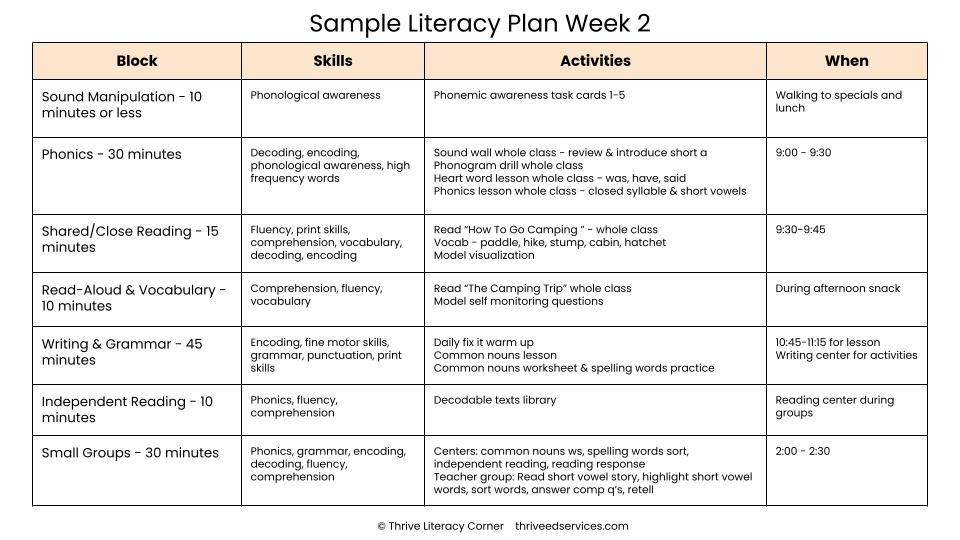
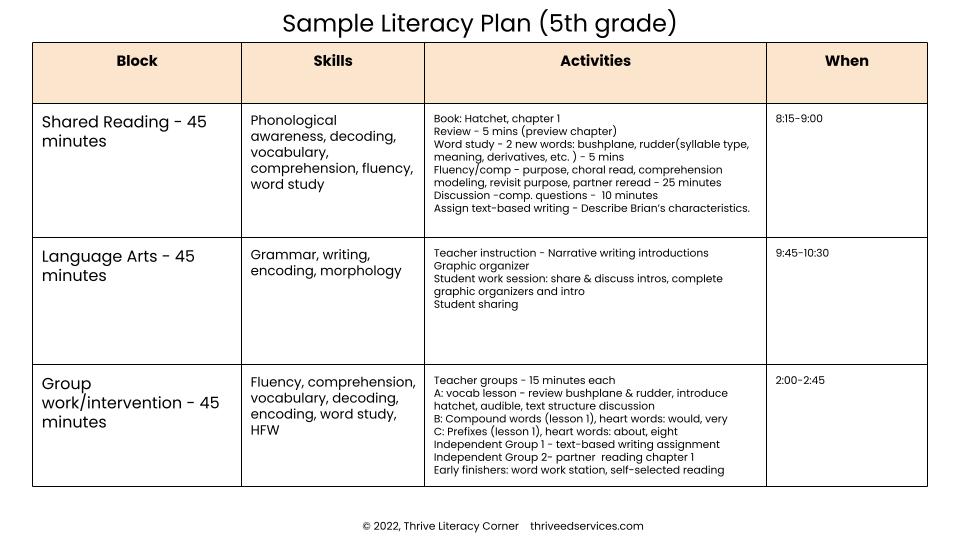
I hope this post helps you plan out your literacy instruction. If you need a more specific guide and outline to follow, I recommend the books How to Plan Differentiated Reading Instruction (grades k-3) and Differentiated Literacy Instruction in Grades 4 & 5.
Sources:
- Principles of Effective Literacy Instruction, Grades K-5 by Seth A. Parsons and Margaret Vaughn
- How To Plan Differentiated Reading Instruction K-3 by Sharon Walpole and Michael C. McKenna
- Differentiated Literacy Instruction in Grades 4 & 5 by Sharon Walpole, Michael C. McKenna, Zoi A. Philippakos, and John Z. Strong
Want to remember this? Save How To Set Up Literacy Blocks That Align With the Science of Reading to your favorite Pinterest board!
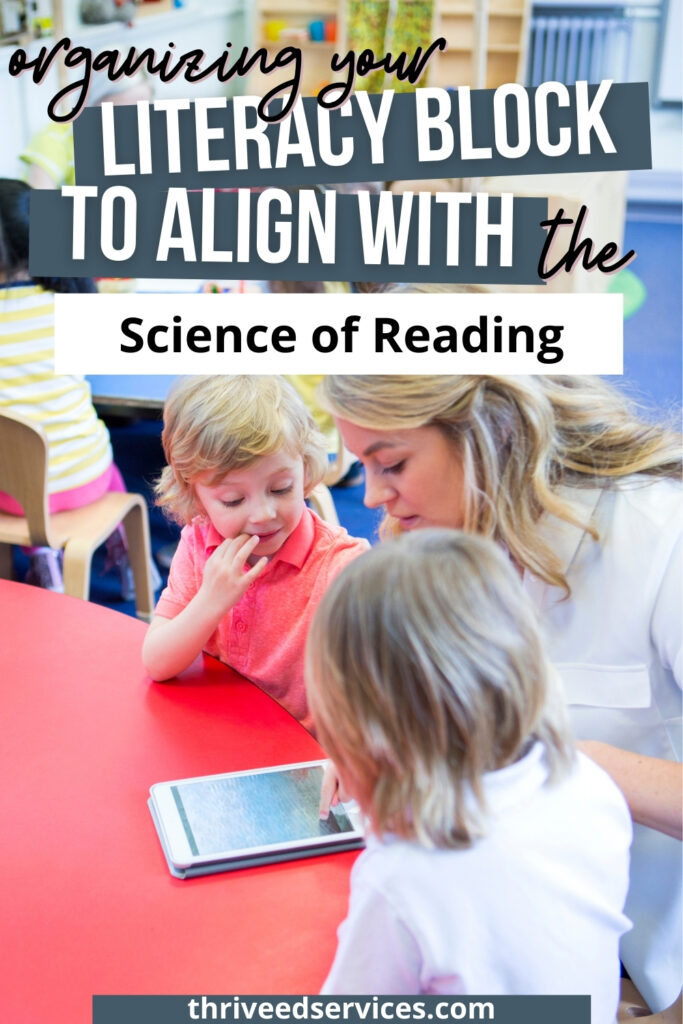
If you’re looking for more tips on teaching reading to struggling learners, check out these other posts:
- What is the Science of Reading
- Teaching High Frequency Words Using the Heart Word Method
- Phonemic Awareness Strategies & Activities For Struggling Learners
- The 6 Syllable Types
- Why You Should Switch To A Sound Wall
- Reading Strategies for Struggling Readers – Elkonin Boxes
- Teaching Reading Comprehension Strategies – My Secret Tip To Improve Reading Comprehension
- Multisensory Strategies for B & D Reversals – Dyslexia Intervention
- Multisensory Spelling Strategy for Struggling Learners – Dyslexia Spelling Strategy
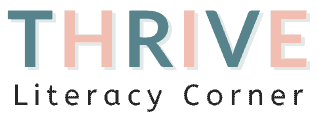
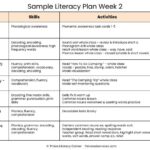
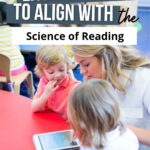
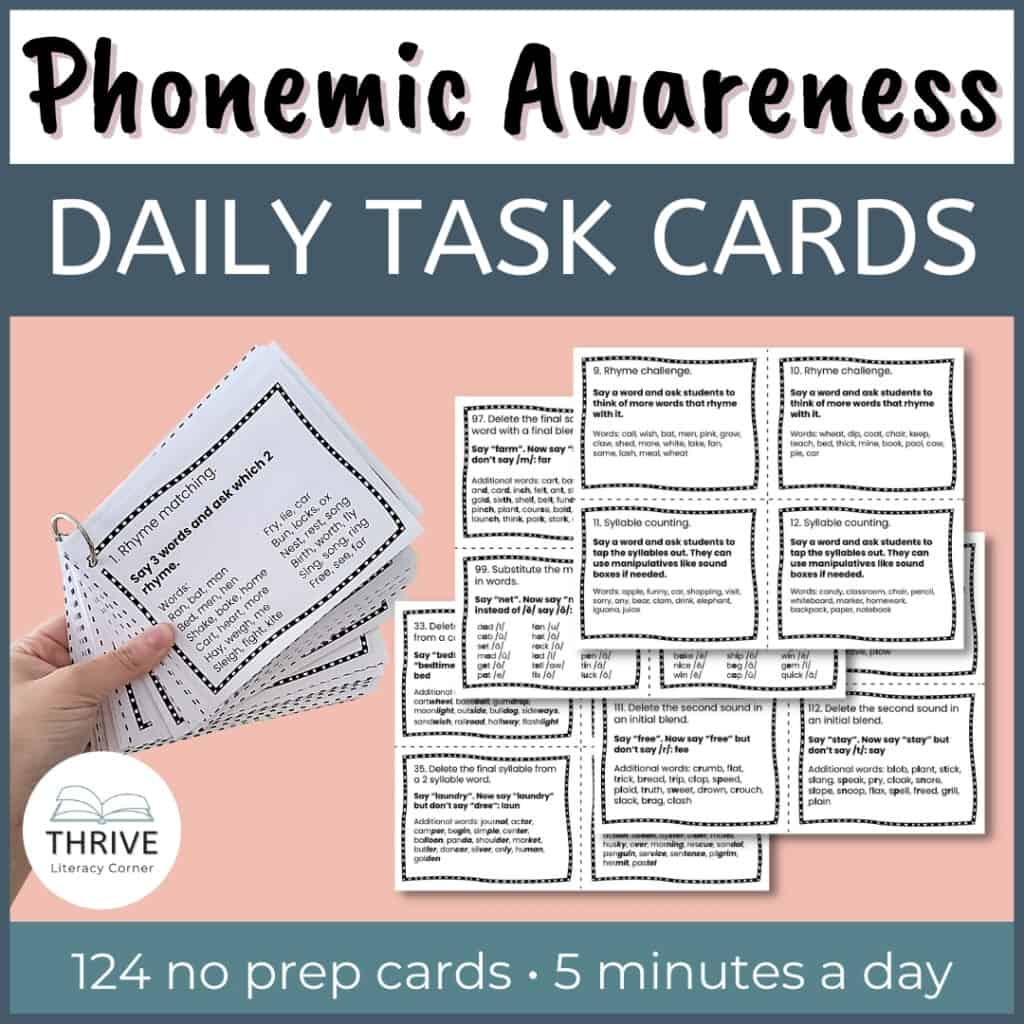
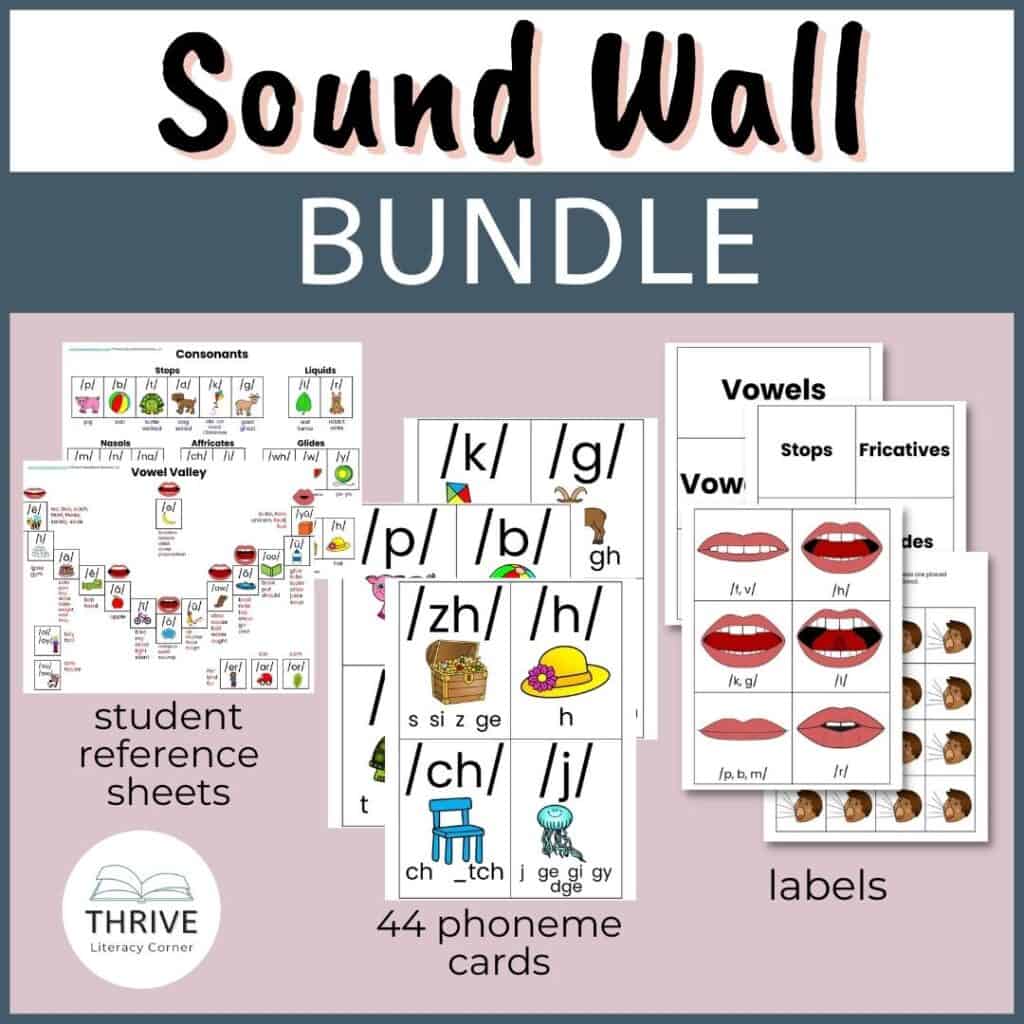
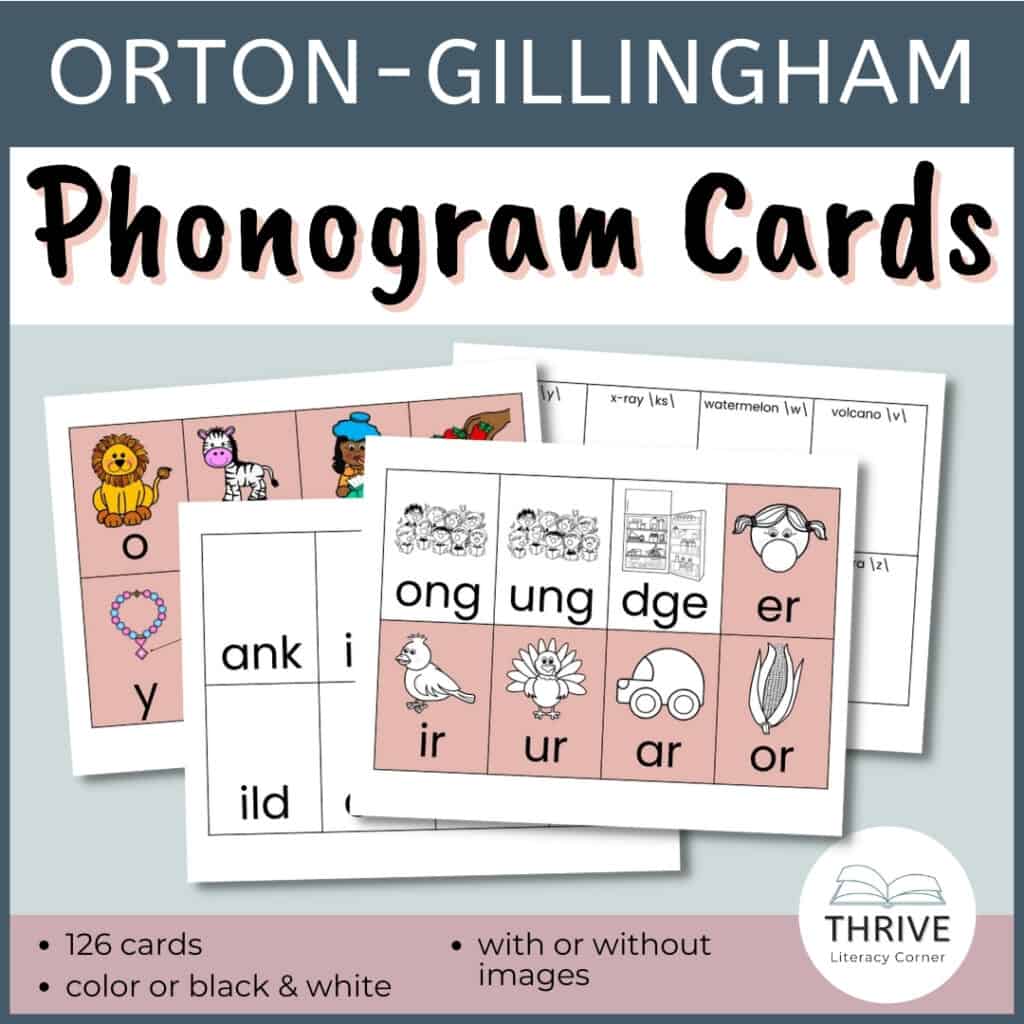
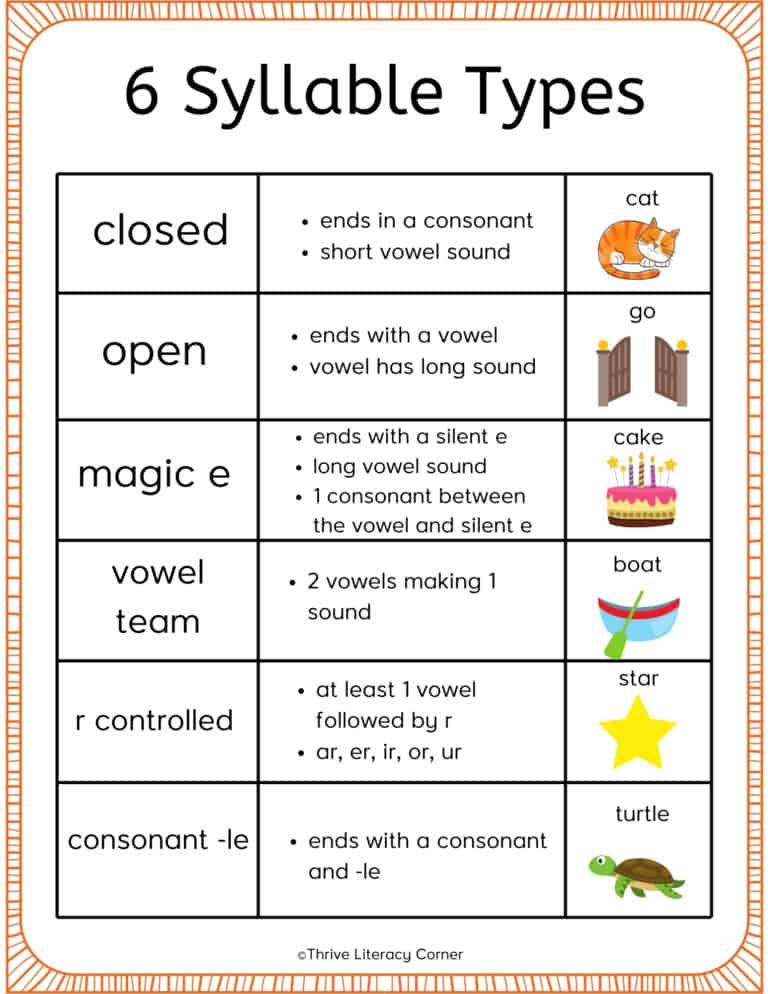
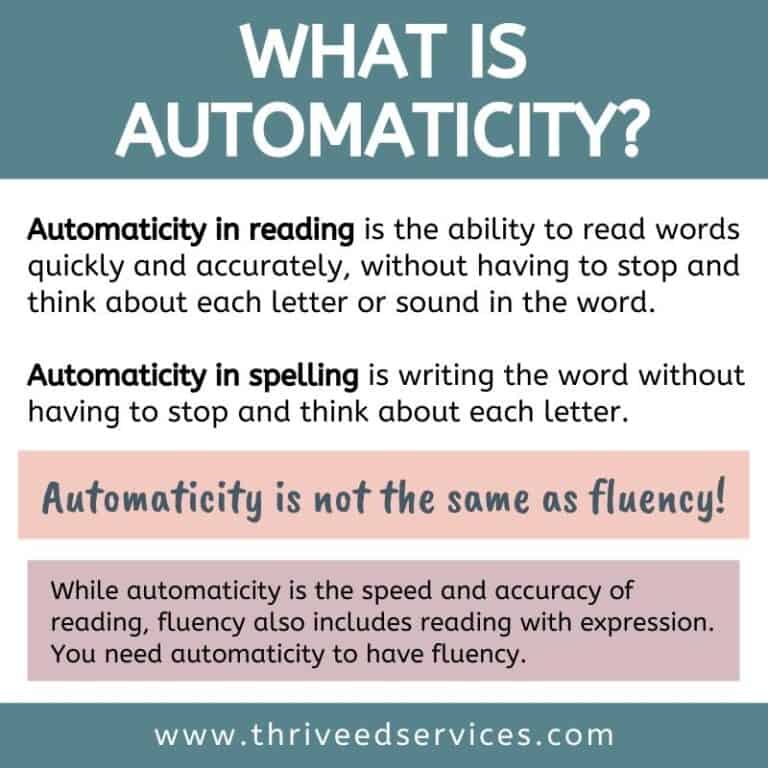

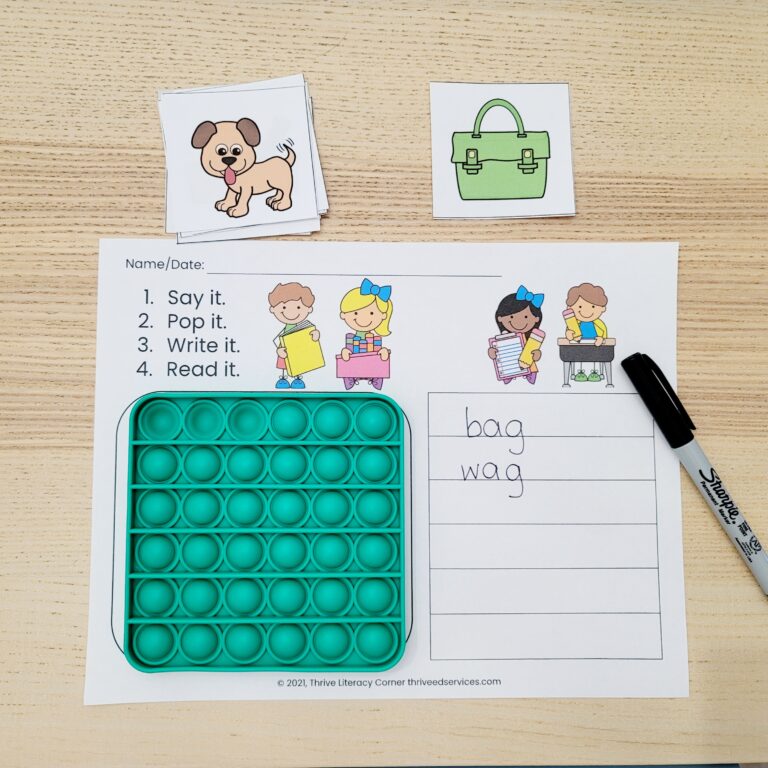
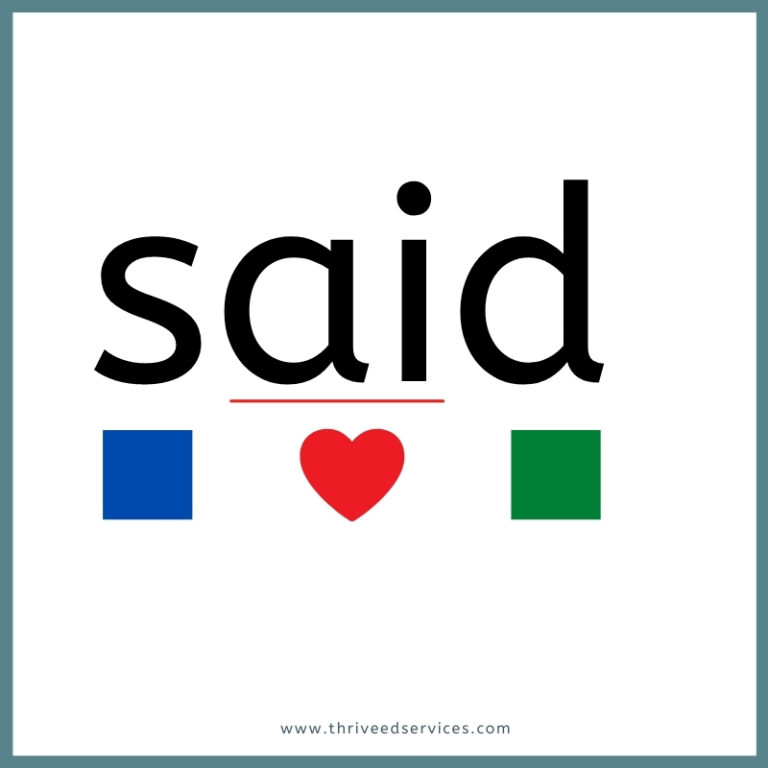
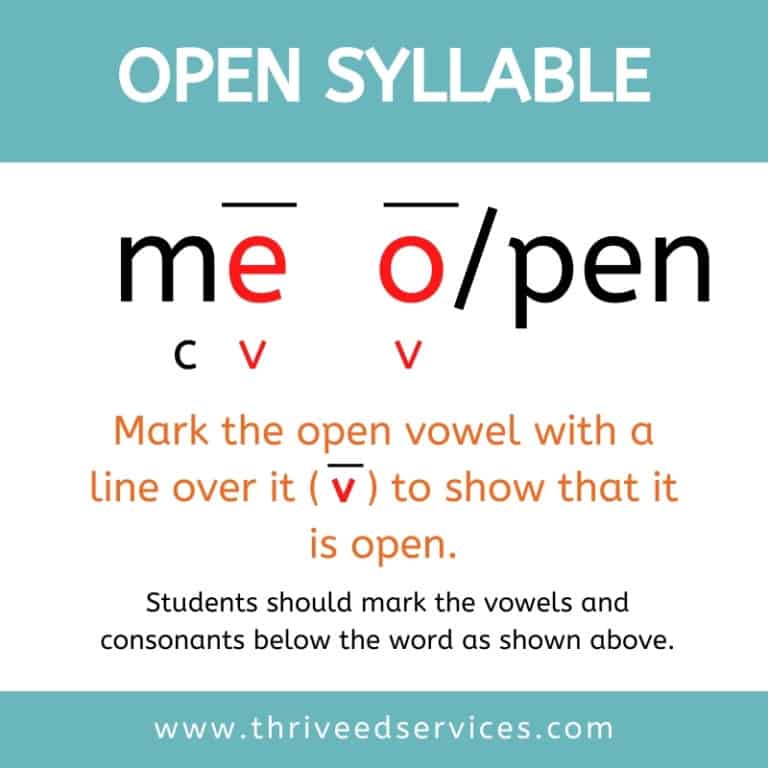
This is great. Do you have an example schedule for grades 3-5?
Thanks Lisa. I do not but I am working on adding that as soon as I can.
Thank you so much Lisa. All of your direction is amazing and helpful . I also love the Science of Reading.
I’m sorry Deliah. Not sure what my computer did.
Thank you Again
This is a great website! So much explicit information for teachers to follow SOR. I have recommended it to many teachers. Thanks for all you are doing,
Thank you so much!
Hi there:
Thanks so much for this info. I bookmarked this site and am using lots of your ideas to plan for the upcoming year.
In your “Sample Literacy Schedule for grades 4-5” you have “word study” listed under both Shared Reading and Group work/intervention, and “spelling lessons” under Language Arts. I want to implement morphology / spelling this year with my 4th graders, and I’m unclear on whether to do this with small groups or whole group. Can you comment on this?
Thank you again…
Jen
Hi Jen. Thanks for the feedback. The sample activities are just several of the options within that block that you can use. Word study/spelling can be addressed in either grammar or shared reading. Typically it comes up organically in shared reading, when a student questions a word. This would be a quick discussion instead of a full lesson that would be used during grammar time. Group intervention would address whatever area the students need, so it could show up there as well. I would focus your spelling instruction during whole group, and work more on spelling in small groups only with the students who need it. Hope this helps – Delilah
Perfect, thanks for your quick feedback!